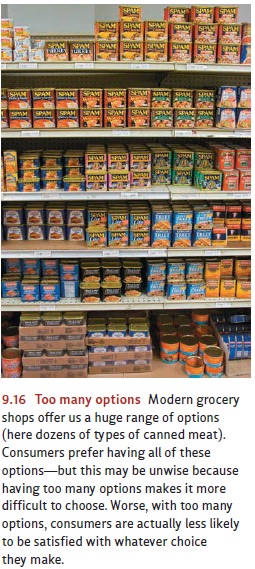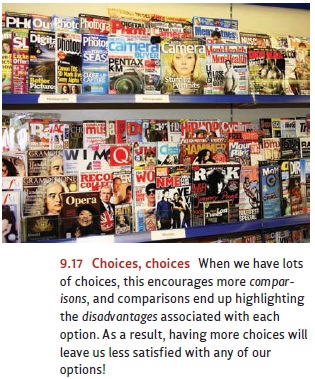Chapter: Psychology: Thinking
Decision Making: Too Many Options
Too Many
Options
Framing effects and poor
affective forecasting are both obstacles to consistent, high-quality decision
making. Yet another obstacle comes from a surprising source, because our
decisions are sometimes undermined by our simply having too many options to
choose from (Figure 9.16).
People like to be in control of
their lives. Indeed, evidence suggests that people are healthier and happier
when they can make their own choices rather than letting some-one else make
decisions for them . But in order to make choices, we need to have
options—otherwise, there are no choices to make! And presumably, if hav-ing a
few options is a good thing, then having more options is better still—because
then we have enormous freedom to choose exactly the option that suits us best.

As a number of studies have made
clear, though, this is a setting in which it’s possi-ble to have “too much of a
good thing.” In particular, if people are given too many choices, they’re
likely to make no selection at all. In one study, visitors to a grocery store
encoun-tered a table offering free samples of high-quality jams (Iyengar &
Lepper, 2000). In one condition of the experiment, the table offered 6
varieties, and shoppers could taste as many of these as they wished. In another
condition, the table offered 24 varieties, and again shoppers could choose the
ones they wanted to try. The shoppers plainly showed a preference for having
more options to choose from—of the shoppers who passed the 6-varieties table,
40% stopped to examine the display; of the shoppers who passed the 24-varieties
table, 60% stopped to look.
Unmistakably, then, people like
having lots of choices. However, once they have those choices, they seem put
off by the sheer variety of options. Of the (many) shop-pers who visited the
24-varieties table, only 3% actually purchased a jar of jam. In sharp contrast,
of the shoppers who approached the 6-varieties table, nearly 30% purchased a
jar—a 10-to-1 differential!
In addition, when we have too
many options or too much flexibility we often end up less satisfied with our
selection. In one study, participants were asked to select a photo-graph that
they would keep at the end of the experiment (D. Gilbert & Ebert, 2002).
Half of the participants were told that they had to make their final choice
right away; the other participants were told that they had to make a selection
but could revise this choice later if they wished to. Participants liked having
this flexibility, but in fact they didn’t benefit from it at all: Participants
who had to stick with their initial choice actu-ally ended up, in the long run,
more content with their selection than did the partici-pants who had the option
of revising their choice.
Several factors contribute to
these results, but part of the explanation lies in the impact of making
comparisons. We noted earlier (in our discussion of loss aversion) that people
are keenly sensitive to losses and do all they can to avoid them. In the same
way, people are also very sensitive to an option’s disadvantages, and so they give these more weight than the
advantages (the gains) associated with the same option. Thus, in concrete
terms, when people compare one photograph to another, or one jam to another,
they pay special attention to the things they don’t like about each option (its
limitations and drawbacks) and attend less to the aspects they do like. As a
result, the comparison ends up highlighting the negative features of each
choice—with the result that all the options generally look worse after the
comparison (i.e., their drawbacks are now salient) than they did before.
Let’s now add the fact that, when
you have more options to consider, you’ll end up doing more comparisons among
the options. Likewise, if you have the flexibility to revise your choice, this
too encourages more comparison—because you make your selection, but continue
mulling over your options, to make sure you picked the best one. In either
case, more comparison translates into even greater salience for each option’s
disadvantages. Thus, in the jam experiment, the greater variety (leading to
more com-parisons) makes all the choices look worse—and so you choose none of
them. In the photography experiment, the extended comparison makes your
selected option look worse—and so the option to revise your choices leaves you
less content with the deci-sion’s outcome.
In fact, this negative effect of
making comparisons can be documented directly. In a study that we first met in
the prologue, people in one condition were invited to evaluate options one by
one—they were asked, for example, the highest price they would be willing to
pay for a 1-year subscription to People
magazine (Brenner, Rottenstreich, & Sood, 1999). In a different condition,
people were asked about four different magazines (Figure 9.17). They were first
asked to rank the magazines from most favorite to least favorite and then asked
the price they would pay for each one. The latter condition was designed to
encourage comparisons, and this had a power-ful impact: When the participants
rated People magazine on its own,
they were will-ing (on average) to pay more than $21 per year for a
subscription. But when they evaluated People
relative to other magazines, the comparison made People less attrac-tive; and now people were willing to pay (on
average) only $16 per year—almost a 25% decrease.

Related Topics